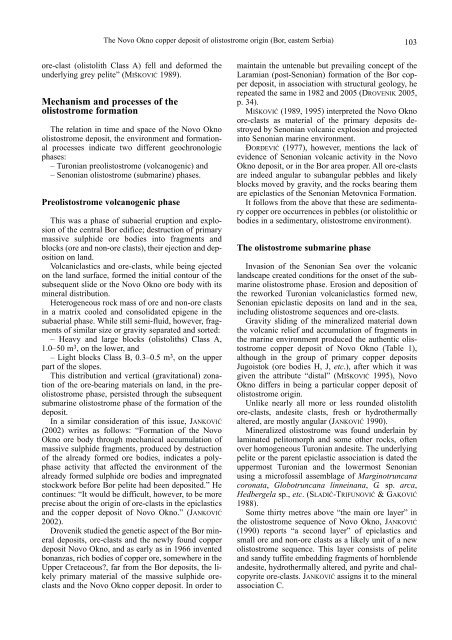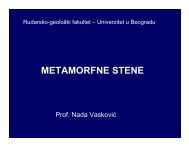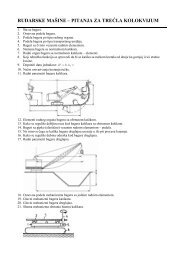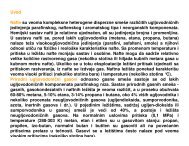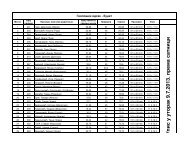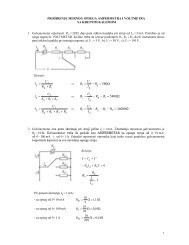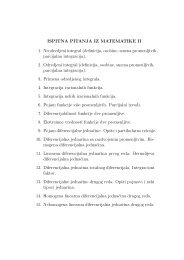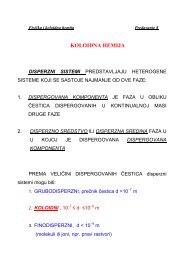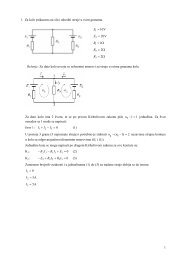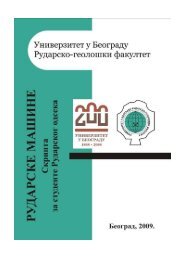KÑига LXXII
KÑига LXXII
KÑига LXXII
Create successful ePaper yourself
Turn your PDF publications into a flip-book with our unique Google optimized e-Paper software.
The Novo Okno copper deposit of olistostrome origin (Bor, eastern Serbia) 103<br />
ore-clast (olistolith Class A) fell and deformed the<br />
underlying grey pelite” (MIŠKOVIĆ 1989).<br />
Mechanism and processes of the<br />
olistostrome formation<br />
The relation in time and space of the Novo Okno<br />
olistostrome deposit, the environment and formational<br />
processes indicate two different geochronologic<br />
phases:<br />
– Turonian preolistostrome (volcanogenic) and<br />
– Senonian olistostrome (submarine) phases.<br />
Preolistostrome volcanogenic phase<br />
This was a phase of subaerial eruption and explosion<br />
of the central Bor edifice; destruction of primary<br />
massive sulphide ore bodies into fragments and<br />
blocks (ore and non-ore clasts), their ejection and deposition<br />
on land.<br />
Volcaniclastics and ore-clasts, while being ejected<br />
on the land surface, formed the initial contour of the<br />
subsequent slide or the Novo Okno ore body with its<br />
mineral distribution.<br />
Heterogeneous rock mass of ore and non-ore clasts<br />
in a matrix cooled and consolidated epigene in the<br />
subaerial phase. While still semi-fluid, however, fragments<br />
of similar size or gravity separated and sorted:<br />
– Heavy and large blocks (olistoliths) Class A,<br />
1.0–50 m 3 , on the lower, and<br />
– Light blocks Class B, 0.3–0.5 m 3 , on the upper<br />
part of the slopes.<br />
This distribution and vertical (gravitational) zonation<br />
of the ore-bearing materials on land, in the preolistostrome<br />
phase, persisted through the subsequent<br />
submarine olistostrome phase of the formation of the<br />
deposit.<br />
In a similar consideration of this issue, JANKOVIĆ<br />
(2002) writes as follows: “Formation of the Novo<br />
Okno ore body through mechanical accumulation of<br />
massive sulphide fragments, produced by destruction<br />
of the already formed ore bodies, indicates a polyphase<br />
activity that affected the environment of the<br />
already formed sulphide ore bodies and impregnated<br />
stockwork before Bor pelite had been deposited.” He<br />
continues: “It would be difficult, however, to be more<br />
precise about the origin of ore-clasts in the epiclastics<br />
and the copper deposit of Novo Okno.” (JANKOVIĆ<br />
2002).<br />
Drovenik studied the genetic aspect of the Bor mineral<br />
deposits, ore-clasts and the newly found copper<br />
deposit Novo Okno, and as early as in 1966 invented<br />
bonanzas, rich bodies of copper ore, somewhere in the<br />
Upper Cretaceous?, far from the Bor deposits, the likely<br />
primary material of the massive sulphide oreclasts<br />
and the Novo Okno copper deposit. In order to<br />
maintain the untenable but prevailing concept of the<br />
Laramian (post-Senonian) formation of the Bor copper<br />
deposit, in association with structural geology, he<br />
repeated the same in 1982 and 2005 (DROVENIK 2005,<br />
p. 34).<br />
MIŠKOVIĆ (1989, 1995) interpreted the Novo Okno<br />
ore-clasts as material of the primary deposits destroyed<br />
by Senonian volcanic explosion and projected<br />
into Senonian marine environment.<br />
ĐORĐEVIĆ (1977), however, mentions the lack of<br />
evidence of Senonian volcanic activity in the Novo<br />
Okno deposit, or in the Bor area proper. All ore-clasts<br />
are indeed angular to subangular pebbles and likely<br />
blocks moved by gravity, and the rocks bearing them<br />
are epiclastics of the Senonian Metovnica Formation.<br />
It follows from the above that these are sedimentary<br />
copper ore occurrences in pebbles (or olistolithic or<br />
bodies in a sedimentary, olistostrome environment).<br />
The olistostrome submarine phase<br />
Invasion of the Senonian Sea over the volcanic<br />
landscape created conditions for the onset of the submarine<br />
olistostrome phase. Erosion and deposition of<br />
the reworked Turonian volcaniclastics formed new,<br />
Senonian epiclastic deposits on land and in the sea,<br />
including olistostrome sequences and ore-clasts.<br />
Gravity sliding of the mineralized material down<br />
the volcanic relief and accumulation of fragments in<br />
the marine environment produced the authentic olistostrome<br />
copper deposit of Novo Okno (Table 1),<br />
although in the group of primary copper deposits<br />
Jugoistok (ore bodies H, J, etc.), after which it was<br />
given the attribute “distal” (MIŠKOVIĆ 1995), Novo<br />
Okno differs in being a particular copper deposit of<br />
olistostrome origin.<br />
Unlike nearly all more or less rounded olistolith<br />
ore-clasts, andesite clasts, fresh or hydrothermally<br />
altered, are mostly angular (JANKOVIĆ 1990).<br />
Mineralized olistostrome was found underlain by<br />
laminated pelitomorph and some other rocks, often<br />
over homogeneous Turonian andesite. The underlying<br />
pelite or the parent epiclastic association is dated the<br />
uppermost Turonian and the lowermost Senonian<br />
using a microfossil assemblage of Marginotruncana<br />
coronata, Globotruncana linneinana, G. sp. arca,<br />
Hedbergela sp., etc. (SLADIĆ-TRIFUNOVIĆ & GAKOVIĆ<br />
1988).<br />
Some thirty metres above “the main ore layer” in<br />
the olistostrome sequence of Novo Okno, JANKOVIĆ<br />
(1990) reports “a second layer” of epiclastics and<br />
small ore and non-ore clasts as a likely unit of a new<br />
olistostrome sequence. This layer consists of pelite<br />
and sandy tuffite embedding fragments of hornblende<br />
andesite, hydrothermally altered, and pyrite and chalcopyrite<br />
ore-clasts. JANKOVIĆ assigns it to the mineral<br />
association C.


